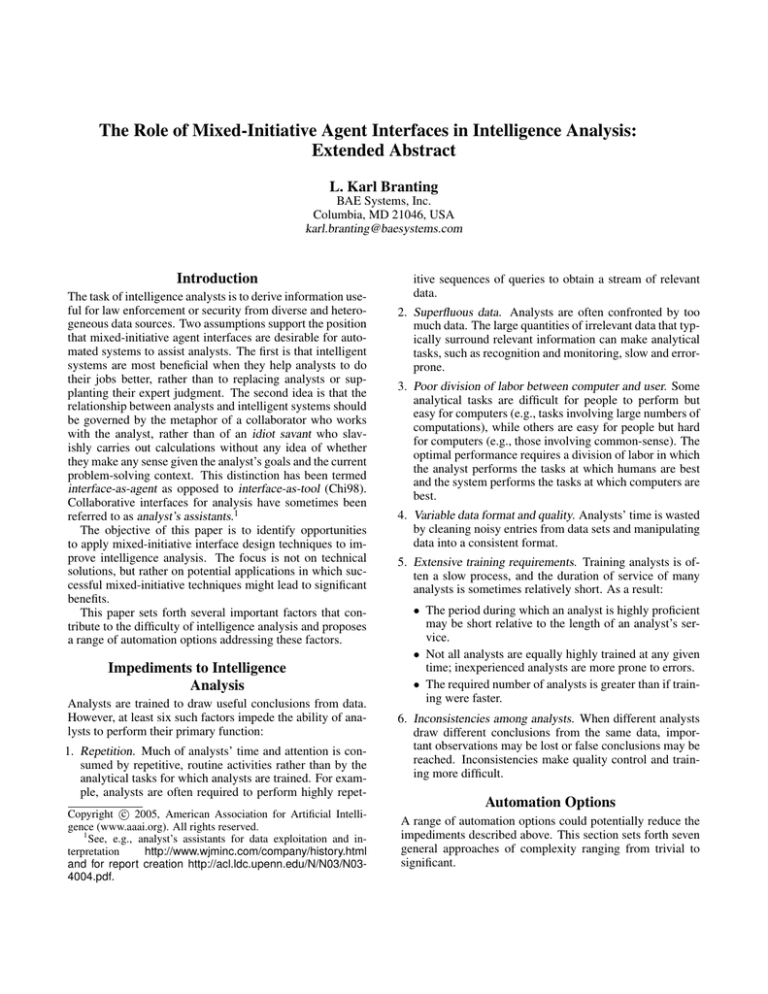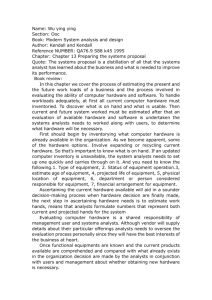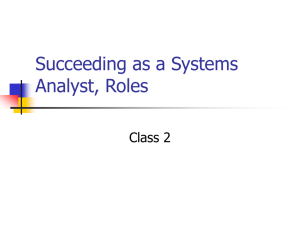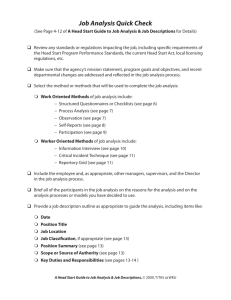
The Role of Mixed-Initiative Agent Interfaces in Intelligence Analysis:
Extended Abstract
L. Karl Branting
BAE Systems, Inc.
Columbia, MD 21046, USA
karl.branting@baesystems.com
Introduction
The task of intelligence analysts is to derive information useful for law enforcement or security from diverse and heterogeneous data sources. Two assumptions support the position
that mixed-initiative agent interfaces are desirable for automated systems to assist analysts. The first is that intelligent
systems are most beneficial when they help analysts to do
their jobs better, rather than to replacing analysts or supplanting their expert judgment. The second idea is that the
relationship between analysts and intelligent systems should
be governed by the metaphor of a collaborator who works
with the analyst, rather than of an idiot savant who slavishly carries out calculations without any idea of whether
they make any sense given the analyst’s goals and the current
problem-solving context. This distinction has been termed
interface-as-agent as opposed to interface-as-tool (Chi98).
Collaborative interfaces for analysis have sometimes been
referred to as analyst’s assistants.1
The objective of this paper is to identify opportunities
to apply mixed-initiative interface design techniques to improve intelligence analysis. The focus is not on technical
solutions, but rather on potential applications in which successful mixed-initiative techniques might lead to significant
benefits.
This paper sets forth several important factors that contribute to the difficulty of intelligence analysis and proposes
a range of automation options addressing these factors.
Impediments to Intelligence
Analysis
Analysts are trained to draw useful conclusions from data.
However, at least six such factors impede the ability of analysts to perform their primary function:
1. Repetition. Much of analysts’ time and attention is consumed by repetitive, routine activities rather than by the
analytical tasks for which analysts are trained. For example, analysts are often required to perform highly repetc 2005, American Association for Artificial IntelliCopyright °
gence (www.aaai.org). All rights reserved.
1
See, e.g., analyst’s assistants for data exploitation and interpretation
http://www.wjminc.com/company/history.html
and for report creation http://acl.ldc.upenn.edu/N/N03/N034004.pdf.
itive sequences of queries to obtain a stream of relevant
data.
2. Superfluous data. Analysts are often confronted by too
much data. The large quantities of irrelevant data that typically surround relevant information can make analytical
tasks, such as recognition and monitoring, slow and errorprone.
3. Poor division of labor between computer and user. Some
analytical tasks are difficult for people to perform but
easy for computers (e.g., tasks involving large numbers of
computations), while others are easy for people but hard
for computers (e.g., those involving common-sense). The
optimal performance requires a division of labor in which
the analyst performs the tasks at which humans are best
and the system performs the tasks at which computers are
best.
4. Variable data format and quality. Analysts’ time is wasted
by cleaning noisy entries from data sets and manipulating
data into a consistent format.
5. Extensive training requirements. Training analysts is often a slow process, and the duration of service of many
analysts is sometimes relatively short. As a result:
• The period during which an analyst is highly proficient
may be short relative to the length of an analyst’s service.
• Not all analysts are equally highly trained at any given
time; inexperienced analysts are more prone to errors.
• The required number of analysts is greater than if training were faster.
6. Inconsistencies among analysts. When different analysts
draw different conclusions from the same data, important observations may be lost or false conclusions may be
reached. Inconsistencies make quality control and training more difficult.
Automation Options
A range of automation options could potentially reduce the
impediments described above. This section sets forth seven
general approaches of complexity ranging from trivial to
significant.
Automation of Routine Non-Analytical Functions.
Multimodal Interfaces.
The simplest automation option is to permit analysts to manually specify patterns of actions to be performed by the interface. This would reduce the first factor listed above, repetition.
Examples of automation of routine non-analytical functions include the following:
• Permitting the analyst to select sequences of actions as
reusable macros, reducing repetitive actions.
• Monitoring, e.g., signaling the occurrence of significant
events, or indicating the current level of some changing
quantity.
• Performing periodic actions, such as executing queries at
regular intervals.
The most straightforward implementation of an interface
design permitting this form of manual customization would
require only basic interface design and usability analysis
(Nie94). Possible mixed-initiative components could include dialogue management for specifying tasks and reporting the results of performing those tasks.
Analysts may differ in the manner of interacting with a computer that they find most intuitive, and a single analyst’s
preferences may change over time. These individual preferences could be accommodated by a flexible user interface
that permitted analysts to select among a variety of different
interaction modalities, e.g., menu-based, text-based, voiceactivated, etc., and interaction style, e.g., mixed-initiative,
user-driven, system-driven.
There are such a wide variety of choices for multi-modal
interfaces that it is impossible to identify a single essential technology, but appropriate technologies include multimedia interface techniques from the intelligence user interface community, natural-language understanding, speechunderstanding, dialogue management and mixed-initiative
interface design.
Auto-customization.
In auto-customization, the system would autonomously tailor the interface to the behavior and preferences of individual
analysts. Examples include the following:
• Recognizing common sequences of actions, compiling
the sequences into macros or templates, presenting them
to the user, and permitting them to be viewed, copied,
edited, ordered by frequency, and displayed.
• Detecting recurring actions and providing analysts the option of monitoring or scheduling periodic tasks based on
these actions.
• Learning analysts’ behavioral preferences (i.e., ordering
relationships on actions), habits, schedules, and behavior.
Auto-customization can be performed without domain
knowledge, requiring instead observations of user’s behavior. For example, behaviorial regularities could be identified
by running an induction algorithm at regular intervals over
a log of analyst’s actions. If regularities are detected, the
system could unobtrusively ask the user whether he or she
would like to (1) compile the pattern into a macro or template for reuse, (2) schedule the sequence for periodic performance, (3) monitor some variables, or (4) make any other
modification of system behavior to conform to the analyst’s
preferences.
The requirements for auto-customization includes a representation language for the actions over which the induction
is performed, and a action ontology to support generalization into templates.
The primary opportunities for mixed-initiative interaction
in auto-customization arise in interacting with the user to determine whether the user would like to accept macros, templates, schedules, or monitoring regimens. This interaction
must be designed carefully, because an interface that bombarded the user with large numbers of proposals would not
be acceptable to most users, particularly if a significant proportion of the proposals were rejected.
Automation of routine analytical tasks
A system with explicit domain knowledge can help automate
portions of analysts’ tasks, including:
• Recognizing relational and temporal structures, such as
plans, social networks, and transactions. The required
domain knowledge includes a model of plan structures,
e.g., goals, states, operators, hierarchical task decomposition networks, etc. (JLM04). The technology required
includes link detection, plan recognition, graph indexing
and pattern matching techniques.
• Finding patterns of information in text. The required techniques include standard text mining and information extraction, including hidden-Markov models and other statistical language models, POS tagging, shallow or deep
parsing, and semantic analysis.
• Manipulating data into a standard format. This would require knowledge of the structure of target data, and could
be performed using information extraction or other data
mining techniques, depending on the condition of the target data.
There are numerous opportunities for mixed-initiative interaction in a system that uses domain knowledge to perform
analytical tasks, including (1) dialogues in which the analyst
specifies his or her goals, which could include requests for
clarification or more information from the system, and (2)
relevance feedback from the analyst.
Acquiring additional domain knowledge to
improve performance in analytical tasks.
If a learning component is added to system with explicit domain knowledge, a number of opportunities for improving
and customizing performance.
• Learning by observing analysts’ actions and behavior,
e.g., learning to recognize and anticipate analyst’s goals.
This is an extension of auto-customization, but with the
addition that analysts’ actions are interpreted in terms of
underlying domain model, so the system can learn actions
that are steps in similar plans even if the actions themselves are dissimilar.
• Active learning, i.e., selecting and asking questions that
best discriminate among competing hypotheses.
• Learning by being told, e.g.,
– Learning new lexical or taxonomic information
– Learning to recognize new kinds of plans
• Exploration, e.g., of web.
Active learning is a particularly important opportunity
for mixed-initiative acquisition of domain knowledge. It is
very unlikely that any system can acquire error-free domain
knowledge. As a result, the acquisition of domain knowledge would requiring interaction between system and user
to (1) identify opportunities for learning, (2) correct or extend domain knowledge, (3) select between hypotheses, or
(4) integrate new information into existing knowledge structures.
Training.
A system with an explicit domain or task model can help
train analysts by:
• Answering procedural and substantive questions
• Providing suggestions
• Recognizing instructional opportunities
• Pedagogical planning, i.e., devising ways of teaching analysts important skills or declarative knowledge.
All mixed-initiation techniques developed for Intelligent
Tutoring Systems would be applicable to the specific task of
training analysts.
Continuity and cross-analyst consistency.
An important function of an analyst’s assistant would be
to maintain knowledge about analysts’ practices to provide
consistency over time and identify divergences between difference analysts and between individual analysts and the
norm. A mixed-initiative interface would be important for
this function because interaction with the system might take
a variety of different forms depending on the context and
the user. The system might function as an intelligent tutoring system for a novice and as a question-answering system
for a more experienced analyst. The system might monitor
analysts’ activities, signaling when anomalous behavior is
observed. In general, maintaining the optimal balance between actively engaging the analyst and passively responding to queries would require a detailed user model.
Conclusion
This paper has briefly sketched some opportunities for
mixed-initiative agent interfaces to address the primary
problems faced by intelligence analysts. Implementation
of specific mixed-initiative components will require extensive analysis of individual analyst’s tasks. However, the
range and complexity of tasks arising in intelligence analysis makes it a challenging and potentially rewarding area
for research in mixed-initiative techniques.
References
D. Chin. Readings in Intelligent User Intefaces, chapter
Intelligent Interfaces as Agents, pages 343–358. Morgan
Kaufmann Publishers, Inc., 1998.
P. Jarvis, T. Lunt, and K. Myers. Identifying terrorist activity with AI plan recognition technology. In Proceedings of
the Sixteenth National Conference on Innovative Applications of Artificial Intelligence (IAAI 2004), pages 858–863,
San Jose, California, July 25–29 2004. AAAI Press.
J. Nielsen. Usability Engineering. Morgan Kaufmann,
1994.







